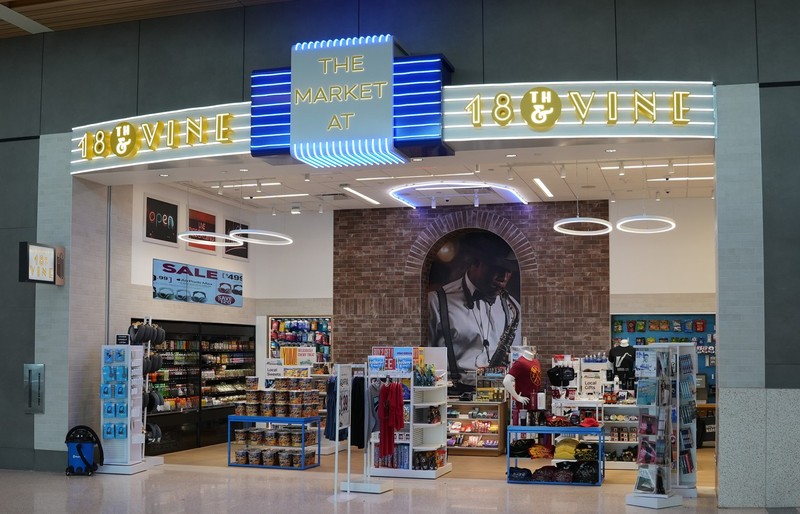Made of KC by Isaac Tapia and Rodrigo Alvarez
Introduction
Author-Uploaded Audio
00:00 / 00:00
Artists Isaac Tapia and Rodrigo Alvarez talk about creating their murals "Made of KC" and "KC Icons" at the Made of KC Food Hall
Text-to-speech Audio
One of several murals by Isaac Tapia and Rodrigo Alvarez, this work at the entrance to Made of KC Food Hall includes many of the symbols of Kansas City, from the fountain in the center to the jazz musician in front of Union Station. Four of the city's professional sports teams, the Royals, Chiefs, Sporting KC, and the KC Current, have their logos on the four pylons of the city's downtown convention center.
Alvarez and Tapia work together as muralists under the name IT-RA Icons, and were asked to represent iconic Kansas City landmarks for this piece. The duo’s creativity also extends inside the Made of KC Food Hall, where a second large mural, “KC Icons,” encompasses an even greater variety of important local sites.
Walking through the two concourses of Kansas City International Airport, one notices that many restaurants, lounges, and shops are named after famed Kansas City neighborhoods and musicians. Across from the Made of KC Food Hall is Jay "Hootie" McShann's Blues Bar, named in honor of one of the icons of Kansas City jazz and blues.
Images
"Made of KC" Mural - Food Hall Entrance
"KC Icons" Mural inside Food Hall

Backstory and Context
Text-to-speech Audio
Kansas City is known as the City of Fountains, so including these famous water features was a must when local artists Isaac Tapia and Rodrigo Alvarez were asked to create an entrance mural for the Made of KC Food Hall. Along with the fountains, IT-RA Icons, Tapia and Alvarez’s mural team, included Kansas City’s monumental Union Station, the artistic pylons of the Kansas City Convention Center, topped with the logos of Kansas City’s four famous sports teams, and a jazz trumpeter playing in front of Union Station. The artists chose opposing forces of fire and water to represent the cool tones of fountains and jazz, in contrast to the spark and spice of barbecue and sports.
Inside the Food Hall is another expansive mural, showcasing even more of Kansas City’s neighborhoods and sites of interest: on the far left is the famous Scout statue near the World War I Memorial, and the distinctive curves of Kauffman Center for the Performing Arts with the artistic pylons of the city’s Convention Center behind. The Kansas City Power & Light Building’s unique Art Deco silhouette, a plane representing Kansas City’s aviation history, and the Christopher S. Bond Bridge over the Missouri River frame a personal touch by Alvarez and Tapia: a father and son planting a tree, which represents the possibilities for growth in Kansas City. The tree’s blossoms morph into poppies, another nod to the World War I Museum, and connect to KC’s iconic circular Western Auto sign, which leads to the famous shuttlecock sculptures of the Nelson-Atkins Museum of Art, and the neon sign welcoming visitors to Kansas City’s 18th and Vine Jazz District. Kansas City’s sports teams are recognized: a player from the KC Current Women’s Soccer team, a baseball player from the Negro American Leages, and a player from Sporting KC, the men’s soccer team, are represented. A dancer appears behind the fountains of the Country Club Plaza shopping district, followed by the silo of the Kansas City’s Boulevard Brewing Company. On the far right, a Kansas Citian and a saxophonist appear with the Colonnade, from the Concourse in Kansas City’s northeast section, where Tapia and Alvarez originally lived after coming to the U.S. from Uruguay and Mexico City as children.
Rodrigo and Isaac strive to represent the character of the communities they depict, while honoring their unique creative origins and influences. In this way they mirror Kansas City’s eclectic mix of styles, art forms, and diversity, a mix which is reflected in the venues in the airport. The shop across from Jay “Hootie” McShann’s Blues Bar recognizes the 18th and Vine neighborhood. Artwork in the shop reflects iconic residents like Charlie "Bird" Parker and landmarks like the Gem Theatre and the American Jazz Museum that preserve and celebrate the city's contribution to the most uniquely American art form that can still be heard at places like the Blue Room or Mutual Musicians Foundation where musicians perform nightly. The neighborhood also includes the Negro Leagues Baseball Museum and Black Archives of Mid-America.
Cite This Entry
Allen, Brandon, David J. Trowbridge, and Clio Admin. "Made of KC by Isaac Tapia and Rodrigo Alvarez." Clio: Your Guide to History. October 14, 2024. Accessed March 31, 2025. https://theclio.com/entry/170491/tour/2
Sources
About the Artists, IT-RA Icons. Accessed July 22nd, 2024. https://www.itraicons.com/about.
Photo by David Trowbridge
Photo courtesy of the artists
Photo by David Trowbridge
Photo by David Trowbridge

